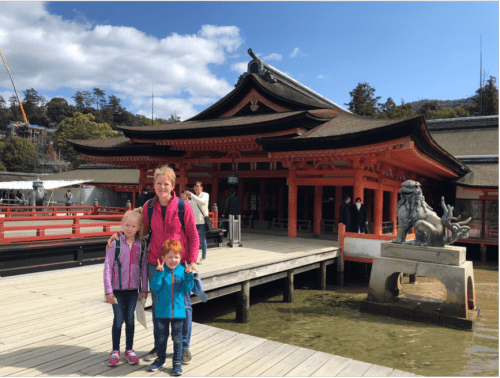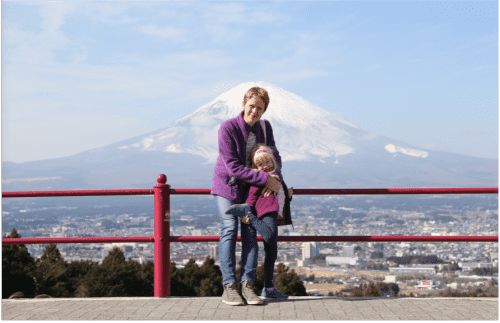ICI’s Dr. Heike Boeltzig-Brown accepted to the US-Japan Council as a Council Leader
Join us in congratulating Dr. Heike Boeltzig-Brown for having been nominated and accepted to the US-Japan Council (USJC) as a Council Leader! Only highly accomplished professionals with significant experience in fulfilling the USJC’s mission are nominated for the honorable Council Leader membership.
Heike together with her children Maisie and Ollie at the entrance to Itsukushima Shrine on Miyajima Island in Hiroshima Prefecture, Japan.
The USJC is dedicated to strengthening US-Japan relations by building connections, developing leaders, and exploring relevant topics and issues that benefit communities, businesses, and government entities in both countries. The Council comprises an impressive network of almost 700 members in the US and Japan from diverse backgrounds and sectors engaged in the USJC’s programs and activities.
Over the past decade, Dr. Boeltzig-Brown has crafted an impressive portfolio of projects that have facilitated the sharing of information and best practices in disability inclusion between the US and Japan. Dr. Boeltzig-Brown has raised approximately $1.6 million to build and support disability leadership capacity in Japan.
We spoke with Heike about her outstanding achievements and how it all got started.
Q: How did you first become interested in this work in Japan?
A: As an undergraduate at the University of Stirling in Scotland, I pursued Japanese studies. During that time, I visited Japan for the first time and became fascinated with the country and its culture. For my undergraduate thesis, I conducted participatory research at a kindergarten for children with disabilities in rural Japan. This first hands-on experience working directly with these children, their teachers, and their parents inspired me to begin examining Japan through a disability lens.
Q: How did you introduce this work to the ICI?
A: Between 2012 and 2020, I worked for the ICI remotely from Tokyo. The first Japan project I led was the Duskin Disability Leadership Program from 2014–2016, which evolved to become the TOMODACHI Disability Leadership Program in America from 2016–2019. This program engaged Japanese students and young professionals with disabilities, ages 18–35, in a 4-month disability leadership training in Boston that included an internship with a disability-focused government or community-based organization.
Q: How did others learn about these programs?
A: In 2019, I led the implementation of a Symposium on Disability and Higher Education called Inclusion Matters in Tokyo. This was a way to integrate the disability leadership programs we led so far, and to leverage their impact for future programming. The event attracted more than 100 attendees and included leaders in disability and career services from top universities across Japan, business leaders, major media outlets and students with disabilities.
Q: Can you tell us more about the impact of this symposium?
A: One important outcome of the symposium was the documentary film that we produced. We made the film specifically for this symposium about student disability experiences. It was called Beyond Access. To make the film, we engaged 11 Japanese students with disabilities in a digital storytelling effort that focused on their disability experiences in university in situations where they have advocated for themselves.This led to more funding and support from the US Embassy Tokyo to continue more of our work.
Q: What did the US Embassy Tokyo support next?
A: After the symposium, we partnered with the American Chamber of Commerce in Japan (ACCJ) on the US–Japan Business Leadership Institute on Youth Disability Employment from 2020–2021. We engaged business leaders in the conversation about disability and work and connected them with universities in Japan with the goal of creating a talent pipeline. This included a 5-part webinar series featuring US–Japan panels with business leaders, educators, and young professionals with disabilities. At the same time, we hosted a mini-grant initiative that provided seed funding to three competitively selected project aimed at creating or enhancing work-based learning opportunities for Japanese college students with disabilities.
Q: Tell us a bit about your current Japan projects. What are you working on next?
A: Last year, I began directing the TOMODACHI Story Jam Program for Youth with Disabilities. This is a 9-week digital storytelling and youth leadership program that brings together 10 Japanese and American college students and young professionals with disabilities each year to collectively explore their experiences of breaking down barriers and advocating for change through digital storytelling. We are in our second year now.
At the same time, I am also implementing the Your Voice, Your Experience, a US–Japan Storytelling and Youth Leadership Program on Diversity and Inclusion which is just getting started and is also funded by the US Embassy Tokyo.
Q: What are you most excited about for the future of your work?
A: I have been fortunate to work with collagues, partners, and sponsors with whom I share a passion for disability inclusion and who have helped me establish a footprint in Japan over the past decade. Now is the time to build on this success and reputation to unify our work so that we can sustain and strengthen disability inclusion efforts in Japan and beyond.
Heike and her daughter Maisie visiting Fuji-Hakone-Izu National Park in Japan, posing for a photo in front of Mt. Fuji (the highest mountain in Japan)
Thank you to Dr. Heike Boeltzig-Brown for sharing her outstanding accomplishments, and congratulations for starting this new position as council leader on the US-Japan Council (USJC)!
